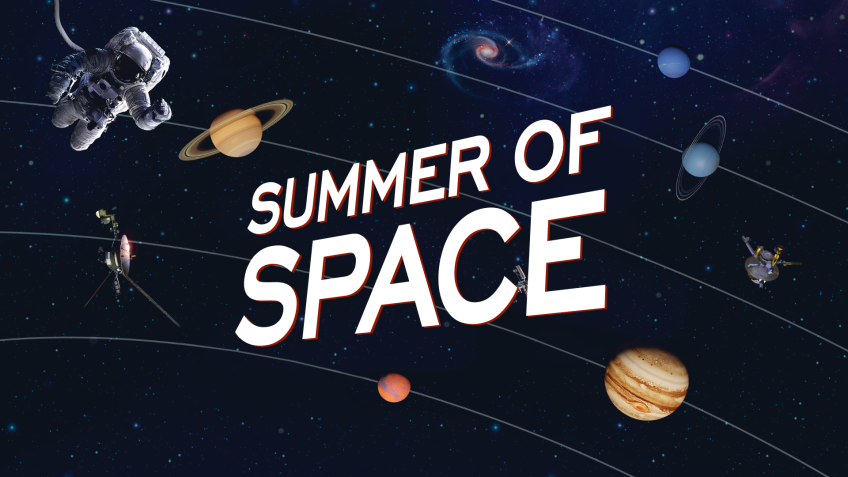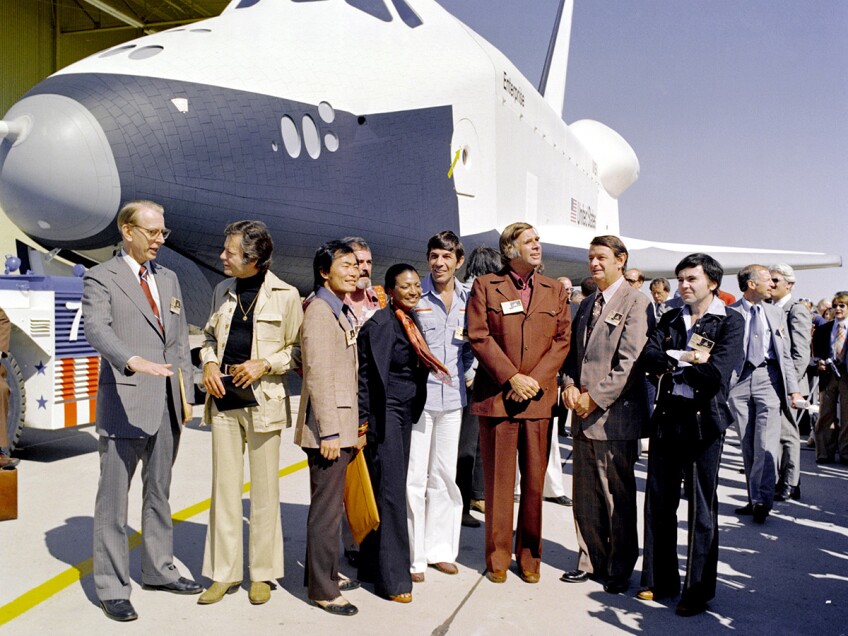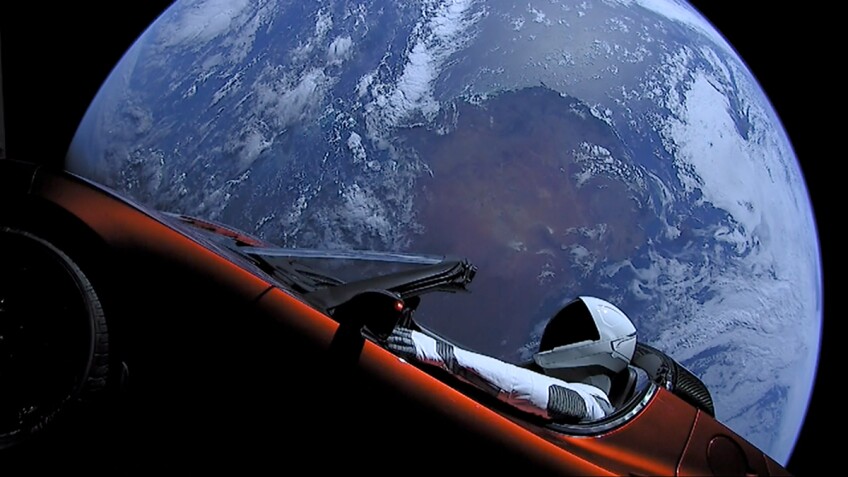The Many Ways Pop Culture Propels Spaceflight and Vice Versa
Relive the excitement of man’s first steps on the moon and the long journey it took to get there with 20 new hours of out of this world programming on PBS SoCal’s “Summer of Space" Watch out for “American Experience: Chasing the Moon” and "Blue Sky Metropolis," four one-hour episodes that examine Southern California’s role in the history of aviation and aerospace.

Space and pop culture have been intertwined for decades, since before men first set foot on the Moon. The fiftieth anniversary of that monumental event is upon us, and that gives us the chance to truly reflect on our nation’s history as a spacefaring society.

Ever since before NASA’s Moonshot, space has played a role in pop culture. Humanity has looked to the stars for centuries, wondering what was out there. As the years and decades progressed, pop culture and space began to feed off one another, each providing the other with endless possibilities and finding a way to make them real. America’s space program is often inspired by and works with science fiction, and sci-fi can often function as a predictor of our spaceflight ambitions.
When you talk about science fiction and pop culture, it’s hard to start with anyone other than French novelist Jules Verne. Long considered the father of science fiction, Verne wrote imaginative and visionary tales in the mid-to-late 1800s. He penned “From the Earth to the Moon,” a novel about launching three people to the Moon using a cannon that involved some surprisingly accurate calculations on launching a projectile into the cosmos, in 1865, over a century before the first lunar landing.
While there were many acts of literature to follow, many of which included more of Verne’s novels as well as authors like H.G. Wells, Hugo Gernsback, and filmmakers like Fritz Lang, pop culture really crystallized around space and American aviation in the 1960s. In 1968, one year before Neil Armstrong and Buzz Aldrin set foot on the Moon, the Stanley Kubrick film “2001: A Space Odyssey” premiered, with Arthur C. Clarke co-writing the script with Kubrick and publishing a movie novelization. The movie is primarily set aboard a spacecraft heading to Jupiter to investigate a mysterious black monolith.

The spaceflight advances shown in the movie may be beyond what we are currently capable of, but there are certainly a few connections that tie in with our own aviation history. The name of the spacecraft is “Discovery,” which is familiar to anyone who knows the history of the Space Shuttle. What’s more, the movie features private citizens flying to space. In real life, the International Space Station, which was assembled in space (another hallmark of “2001: A Space Odyssey”), will begin to play host to private citizens at the bargain price of $35,000 a night. We haven’t quite achieved Clarke and Kubrick’s vision, but our aviation history is slowly catching up to what some of our greatest minds thought the 2000s would look like in terms of space travel.

But there was one franchise that was so seminal to our space program; its very existence is intertwined with NASA’s own history. It was billed as “Wagon Train to the Stars” when it first debuted: It was to be a Western but set in space, exploring the new frontier of space. It was, in fact, the final frontier.
Star Trek was the brainchild of Gene Roddenberry and envisioned a future in which humankind had begun to explore the stars on missions of peace and exploration. The first episode of “The Original Series” aired in 1966, just three years before Neil Armstrong and Buzz Aldrin took their first steps on the Moon. The history of the show is, in many ways, tied into the United States’ spaceflight ambitions and predicted an era when spaceflight wouldn’t be a competition between countries but instead a collaboration, working together in peace to achieve our mutual goals.
The relationship between Star Trek and NASA (and more recently, private spaceflight companies) has been warm. Astronauts have guest-starred on episodes of the show — most notably, Mae Jemison, the first black woman in space, had a cameo on the “Star Trek: The Next Generation” episode “Second Chances,” after episode director and cast member LeVar Burton learned she was a fan and invited her to the set. Countless astronauts, engineers, and more specifically cite the Star Trek franchise as their inspiration for applying to work for the space program.

It’s easy to list the science and technology advancements that Star Trek inspired. But it did more than just influence the terms of research and the direction of our national interest in space.
In 1977, NASA approached actress Nichelle Nichols, who played Lt. Uhura on “The Original Series” for assistance with astronaut recruitment. The organization had decided to step up its efforts to attract women and people of color to the astronaut ranks. While these groups had never been explicitly prohibited from joining the astronaut corps, the stringent early requirements — including test pilot experience — all but ensured the only qualified candidates would be white and male. For the Space Shuttle program, though, NASA was determined to branch out. The only problem was that the people they were interested in hiring weren’t applying because they had historically been excluded from the process. That’s when NASA turned to Nichols.

Thanks to Nichols’ outreach efforts, which included a recruitment video, NASA admitted six women and two black men to its 1978 class. In the 1980s, these astronauts would make aviation history, with Sally Ride as the first American woman in space and Guion “Guy” Bluford as the first black man in space, all thanks to the hard work of a Star Trek actress who spoke out on the need for inclusivity in the people that represent humanity in the stars.
There are few moments of aviation history more poignant than the introduction of a new spacecraft intended to take humans to the stars. When NASA named its first Space Shuttle, one that would be used for in-atmosphere test flights, the organization decided on Constitution. However, then-president Gerald Ford, presumably prompted by a massive write-in campaign organized by Star Trek fans, ordered NASA to change the name to “Enterprise.” The Space Shuttle is now on display aboard the USS Intrepid in New York City.

Star Trek also referenced multiple NASA missions over the course of the franchise’s illustrious history. From the first Moon landing that was referenced in multiple series to the somewhat controversial opening credits of “Star Trek: Enterprise,” which had an homage to American spaceflight by showing scenes from the Apollo 14, the assembly of the International Space Station, and more, the show has constantly paid tribute to what came before in aviation and spaceflight history.
The relationship between aviation history and Star Trek doesn’t stop with where we’ve been; it also helps shape the future of where we are going. The theory of relativity tells us that it is impossible for ordinary matter to travel faster than the speed of light. But that hasn’t stopped NASA and other organizations and scientific institutions from pursuing the technology of faster-than-light travel, or warp drive. One day, we may be able to travel between stars, and the inspiration for that dream will be directly traceable back to Star Trek and perhaps its space fantasy counterpart, Star Wars.

The future of sci-fi is bright, and with it comes endless possibilities in terms of predicting grand moments in our aviation and spaceflight history. Near-future sci-fi movies, television, and books preview the next phase of space travel when we will break free of low-Earth orbit and soar among the stars. “The Martian,” which was penned by Andy Weir and turned into the hit movie starring Matt Damon, is one of the likeliest predictors of where human space travel will head next. The story depicts human missions to Mars in the next two decades; meanwhile, NASA has set a deadline of 2024 to return humans to the lunar surface as a part of Project Artemis, the sister of Apollo. The current plan is to use a Moon base as a springboard for a crewed Mars mission.

“The Expanse,” a book series by James S. A. Corey that has been turned into a hit TV show available in the U.S. on Amazon Prime, takes us a few centuries past “The Martian,” depicting a society that has settled the vast reaches of the solar system. It’s hard to imagine being born, living and dying on other worlds, given where we are in terms of spaceflight now, yet it’s certainly a possibility in the generations to come given the ambitions of public and private spaceflight.
Looking ahead doesn’t mean that the nostalgia and fondness for our past achievements in the realm of spaceflight will wane, though. This fall, a new show from Ron D. Moore, who made a name for himself in the “Star Trek: Deep Space Nine” writer’s room and was the showrunner for “Battlestar Galactica,” will launch “For All Mankind” on the new Apple streaming service. This new show takes on the Moon landing, but with a twist, asking what might have happened if the Russians had won the space race. What would America’s space program look like now if we hadn’t achieved that milestone?
It’s fascinating to look back at pop culture to see how Hollywood and the space program have intertwined, often feeding off of each other for inspiration and direction. In many ways, spaceflight has become a part of pop culture as billionaires like Elon Musk and Jeff Bezos enter the arena, contributing both flash and substance to this new space race. But at its core, the first landing on the Moon is still the heart and soul of aviation history, the seminal event around which much of space-related pop culture revolves. As we head back into the unknown, we are poised to break records once again and make aviation history as we break free of low-Earth orbit.
